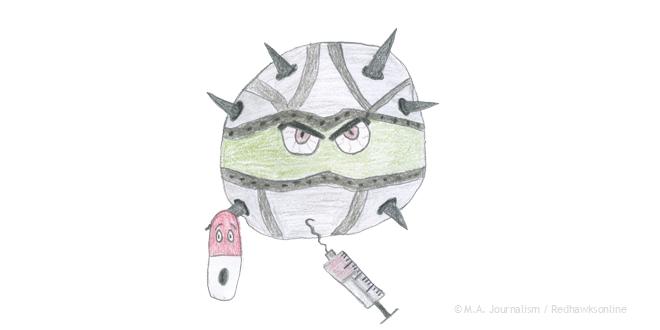The disease fighting effects of antibiotics are rapidly decreasing as they are being excessively used. Could this be the end of antibiotics?
Imagine a typical paper cut. You get cut, apply a bandage and Neosporin and you’re fine. What would happen if that cut left you fighting for your life? Although it seems preposterous, this is a consequence that we may face if modern medicine and our attitudes towards antibiotics don’t change.
Despite the relative youth of the antibiotic era, which arguably began around 1928 with the discovery of penicillin by Alexander Fleming, it may be coming to an end much faster than expected. Through misuse and increased accessibility of antibiotics, bacteria are developing antibiotic resistant strains much faster than in the past, rendering many of our “go-to” medications useless.
“Patients need to understand that there are a very limited number of conditions that require an antibiotic treatment,” said Jon Hallberg, associate professor in the Department of Family Medicine and Community Health at the University of Minnesota. “For a long time, people have assumed that when they’re sick they’re going to get an antibiotic for their illness when in fact most times it’s not necessary.”
Many illnesses such as sore throats, colds and the flu are unnecessarily treated by antibiotics because of the discomfort they cause. Unfortunately, since all of these infections are viral, antibiotics have no effect. Instead, the misuse of antibiotics by patients creates bacterial resistance in bacteria that
survive or come in contact with the antibiotic.
However, medical professionals also face challenges with prescribing antibiotics to patients who feel they need them.
Many times the pressure of patients and the time it takes to explain the issues associated with antibiotics seem to outweigh the consequences and potential dangers.
“The providers also have to be really careful with what we prescribe and how we prescribe it,” said Hallberg. “We often give in to pressure from patients because we simply don’t have the time to explain all the consequences.”
The excessive use of many over-the-counter antibiotics, such as Bacitracin and Neosporin, has been a major factor in the development of antibiotic resistant bacterial strains, but agricultural and food industries have also been culprits in their use of antibiotics to maintain health among cattle and poultry.
In fact, more than 80 percent of the antibiotics sold in the United States are used in the meat and poultry industries, which decrease the effectiveness of those antibiotics for both humans and animals.
These resistant strains have also been increased by overuse due to increased accessibility worldwide.
“In many parts of the world you can go to a pharmacy and get your own antibiotics. You can decide when you need to treat. You can ‘get it off the street’ in a way,” said Hallberg. “It’s a problem all over the world, and we’ve seen some major problems with tuberculosis (TB) and methicillin-resistant staphylococcus aureus (MRSA), which could be serious trouble.”
Unfortunately, TB and MRSA are only a few of the antibiotic-resistant bacteria that have developed into dangerous and difficult to treat infections.
Many of these are acquired in hospitals or highly populated areas where these infections spread easily.
“Many of those [resistant bacteria] appear where there’s poverty and people packed in close together,” said Hallberg. “In jails, in New York and in other places where you have tons of people in close proximity, coughing on each other and breathing the same air, [these bacteria] are a huge problem.”
Fortunately, there are many ways to decrease the risk of these bacteria affecting us. Hallberg argues that small actions such as hand washing and getting sufficient sleep are the best way to start to combat these potentially dangerous bacterial strains.
“The more we can do to take care of ourselves and stay rested, well nourished and hydrated, the less likely those infections become,” said Hallberg.
Hallberg also says that resistance is dependant on use and if people took a break from antibiotics it would also lessen the prevalence of resistant bacteria by reducing the bacteria’s exposure and development in response to these medications.
“If we all took a big break from antibiotics for awhile, we’d have an easier time treating some microbes. The problem [that we face now] is that when bacteria become resistant, it’s evolution as a microcosm and it’s like survival of the fittest,” said Hallberg. “There are campaigns within [the medical community] to educate the public about the overuse of antibiotics and all kinds of campaigns to educate both people in the community and clinicians and people in the hospital as well.”
The fact that the strongest and most resistant bacteria survive when introduced to antibiotics doesn’t bode well for future medicine, but Hallberg argues that we already are making progress in reducing antibiotic resistance and just need to stay informed about necessary treatments and proper uses of medications.
“If we have certain microbes and bacteria [that are resistant to antibiotics] it would be a problem. It would have huge implications for medicine and would be a disaster if suddenly nothing really works on these microbes,” stated Hallberg.
“However, in my opinion we’re doing a way better job now than we were 10 or 20 years ago and the public is really getting the message that those medications don’t need to be taken unless absolutely necessary.”

